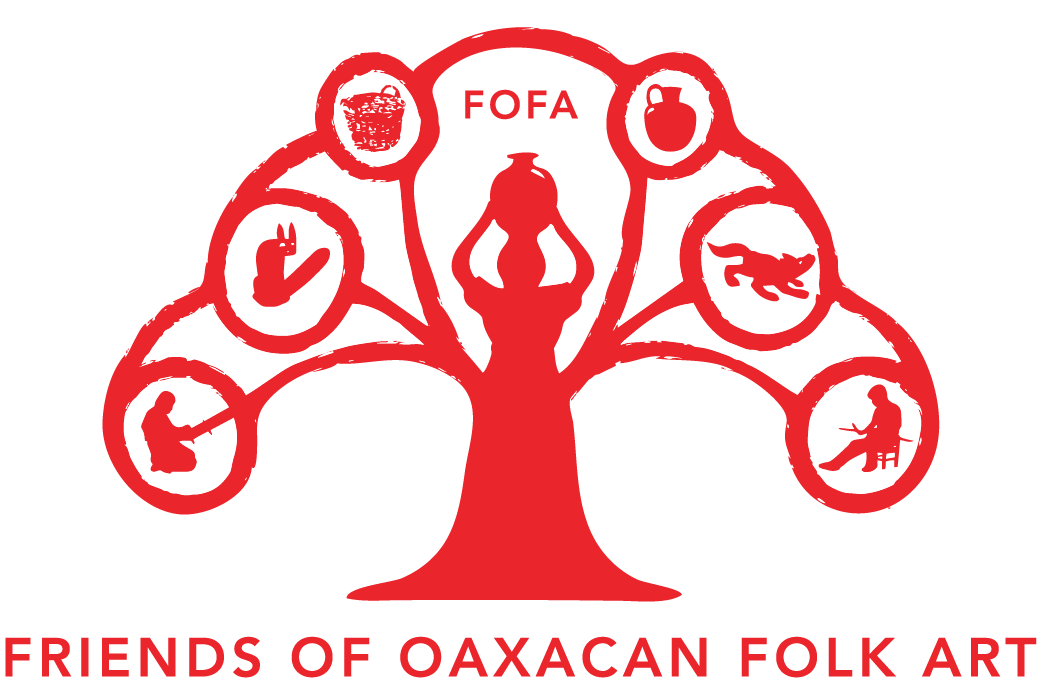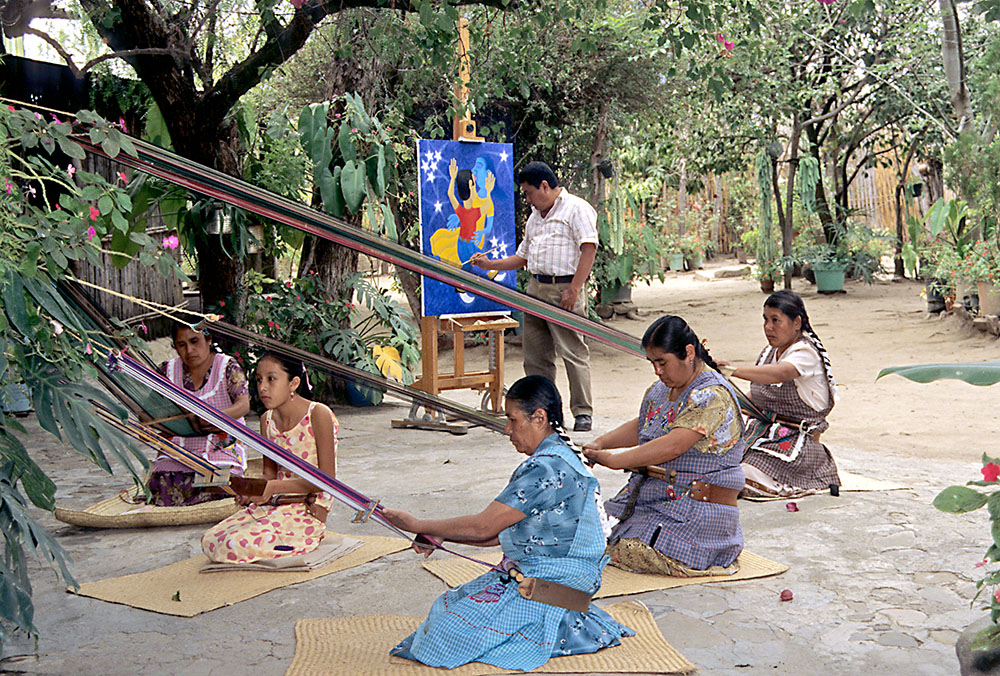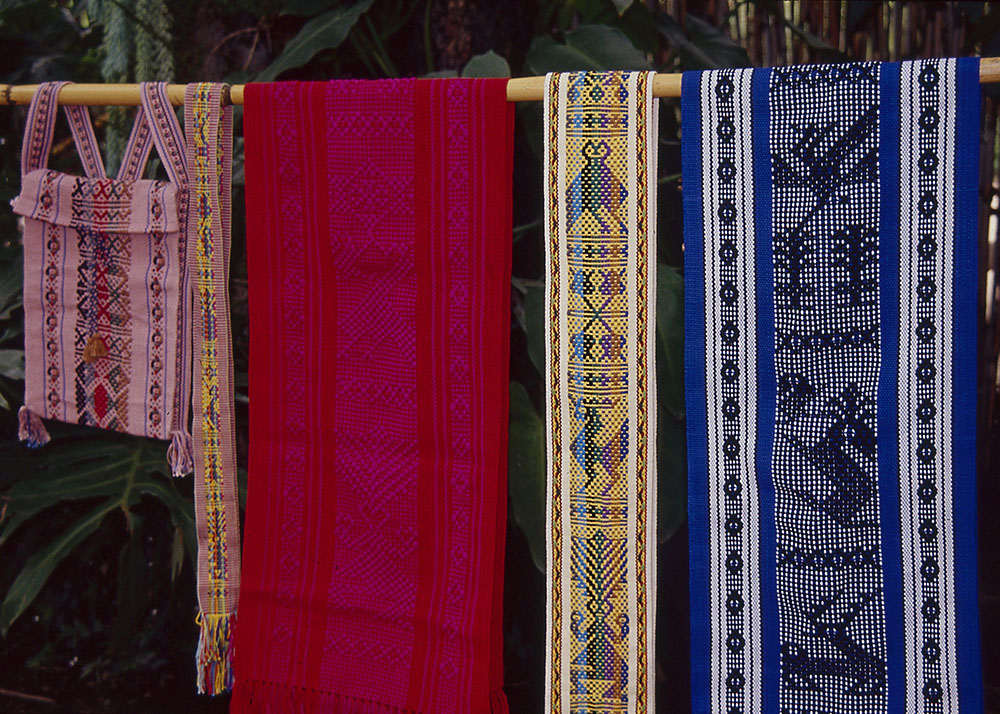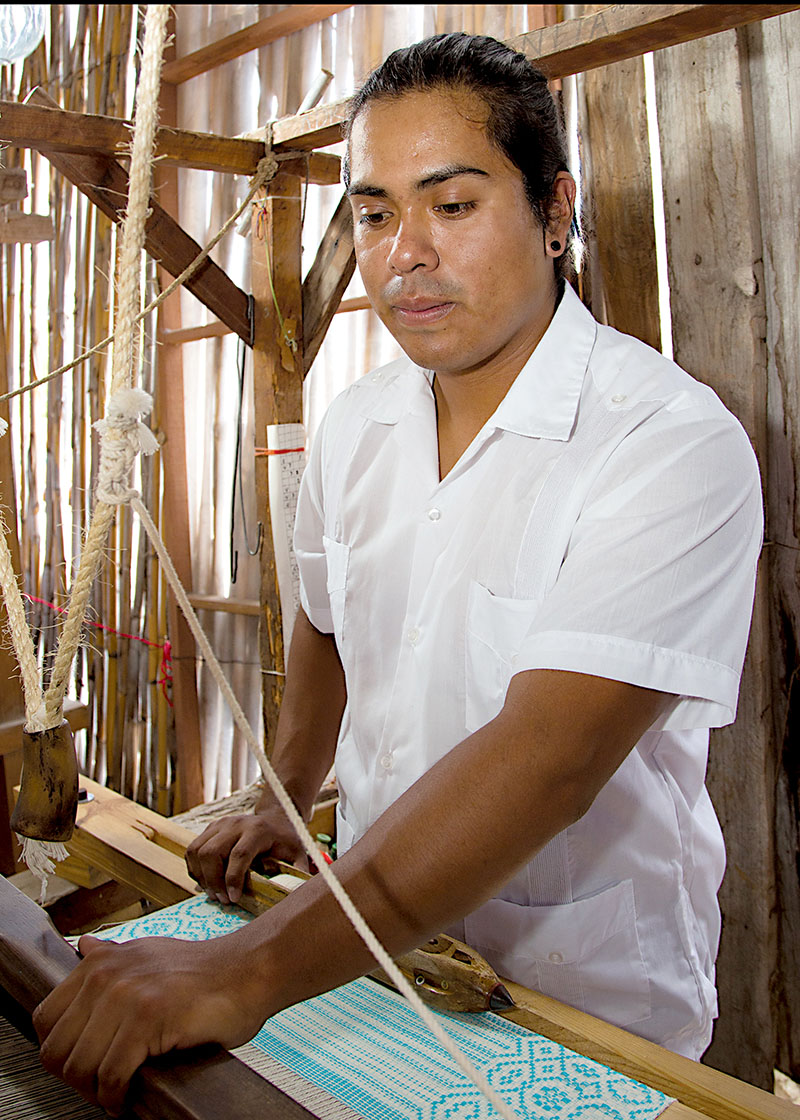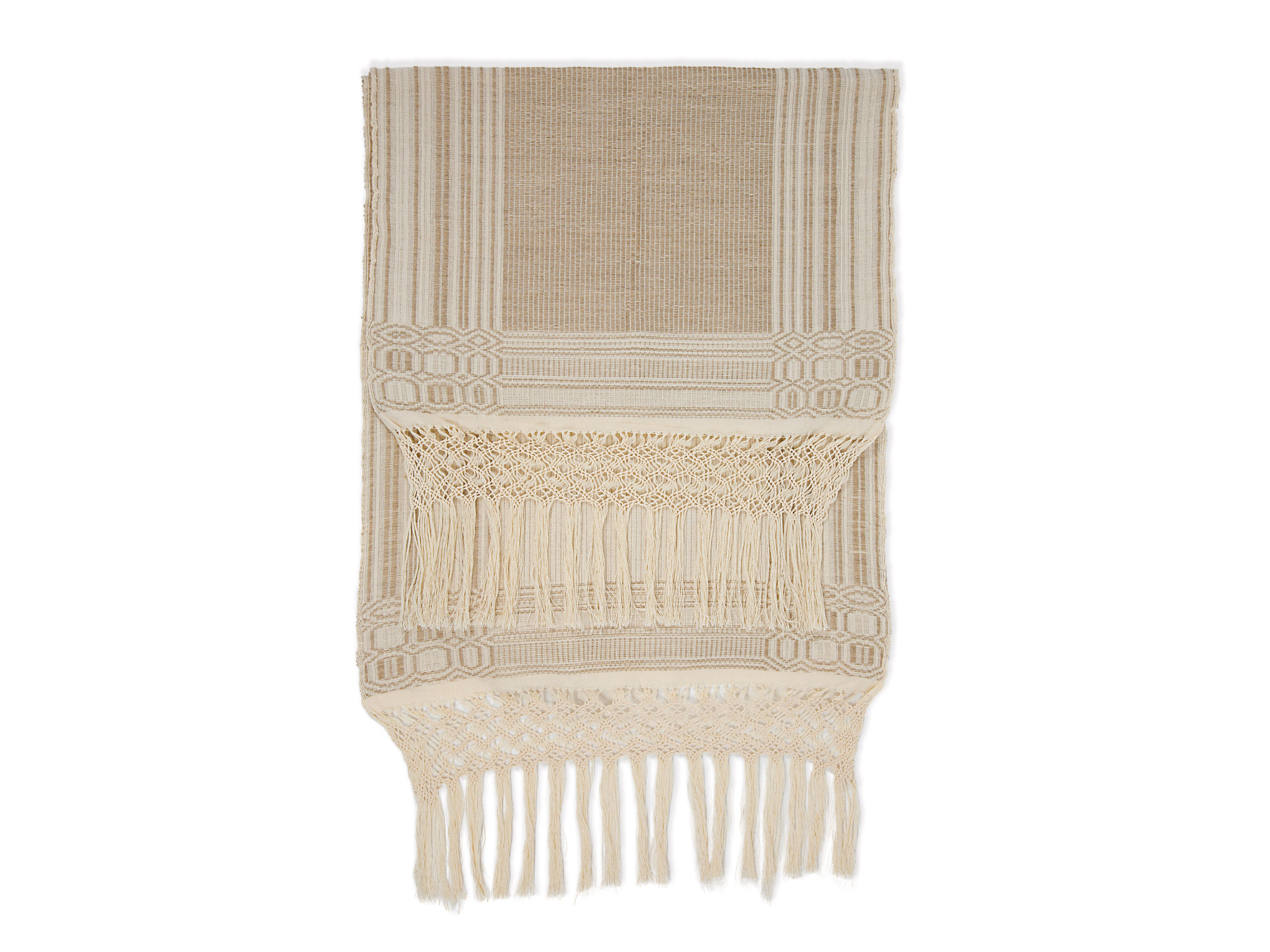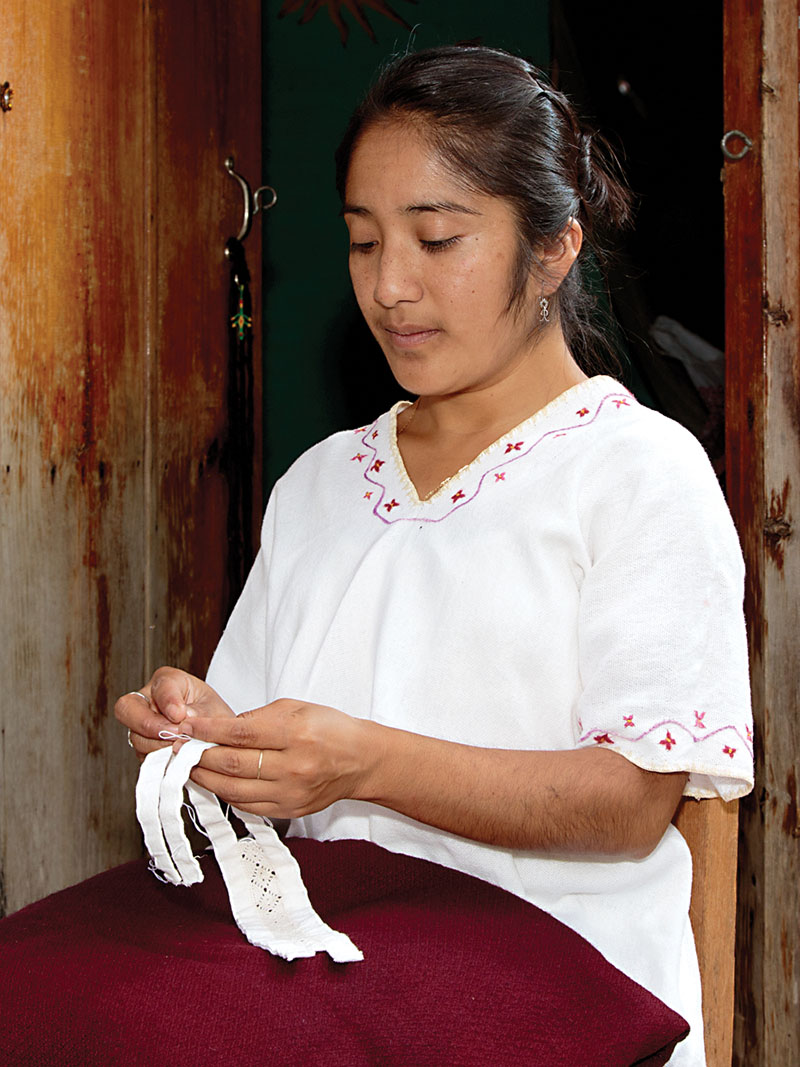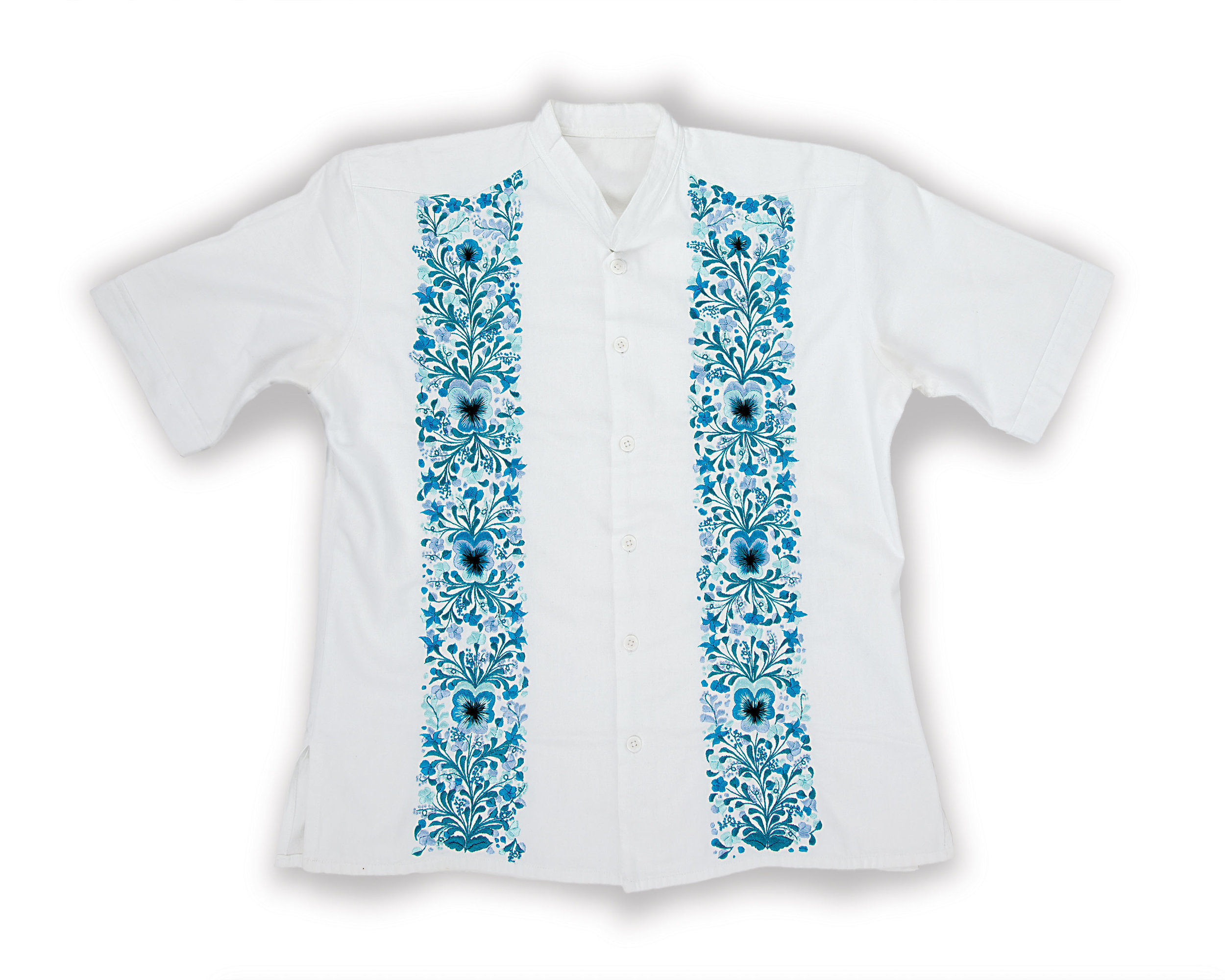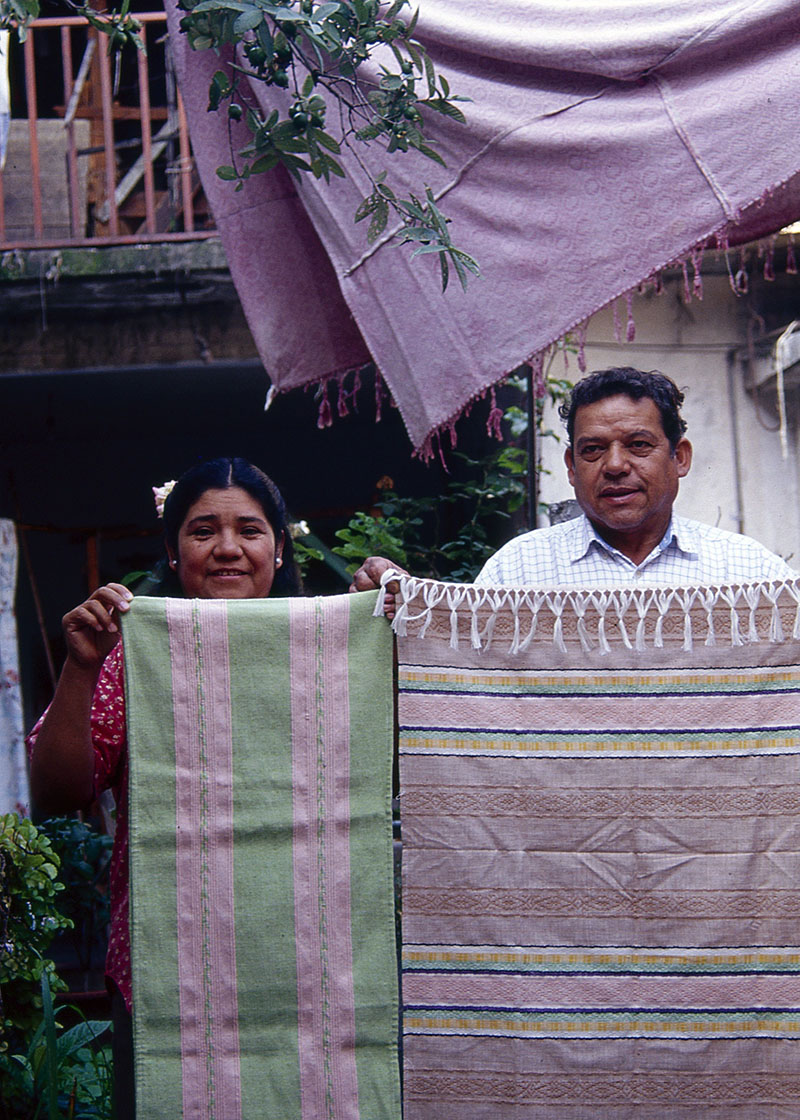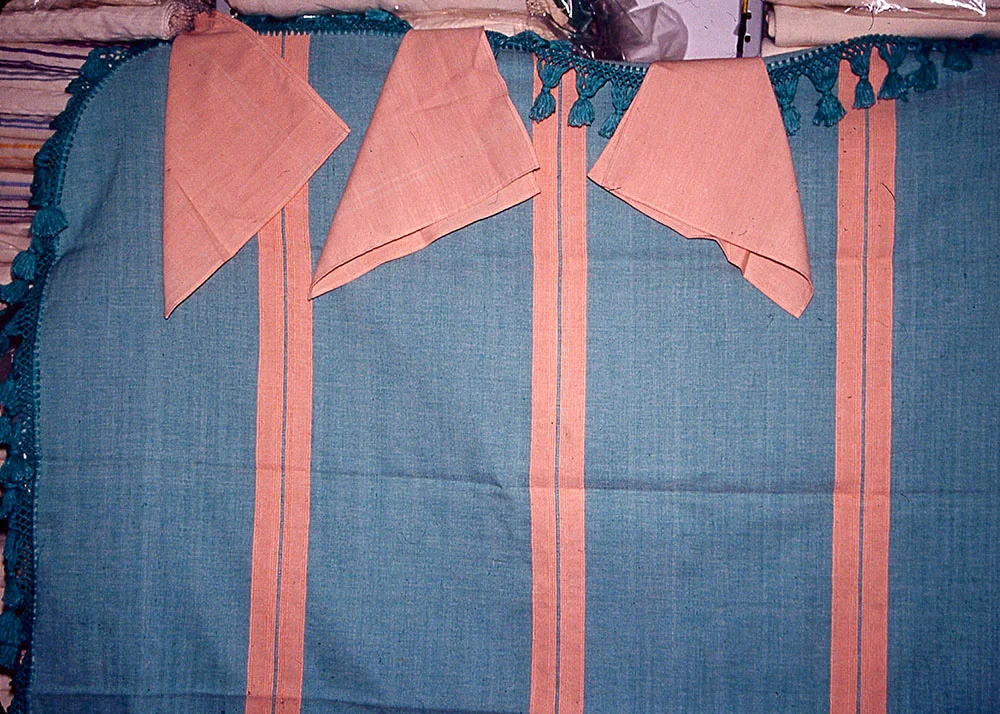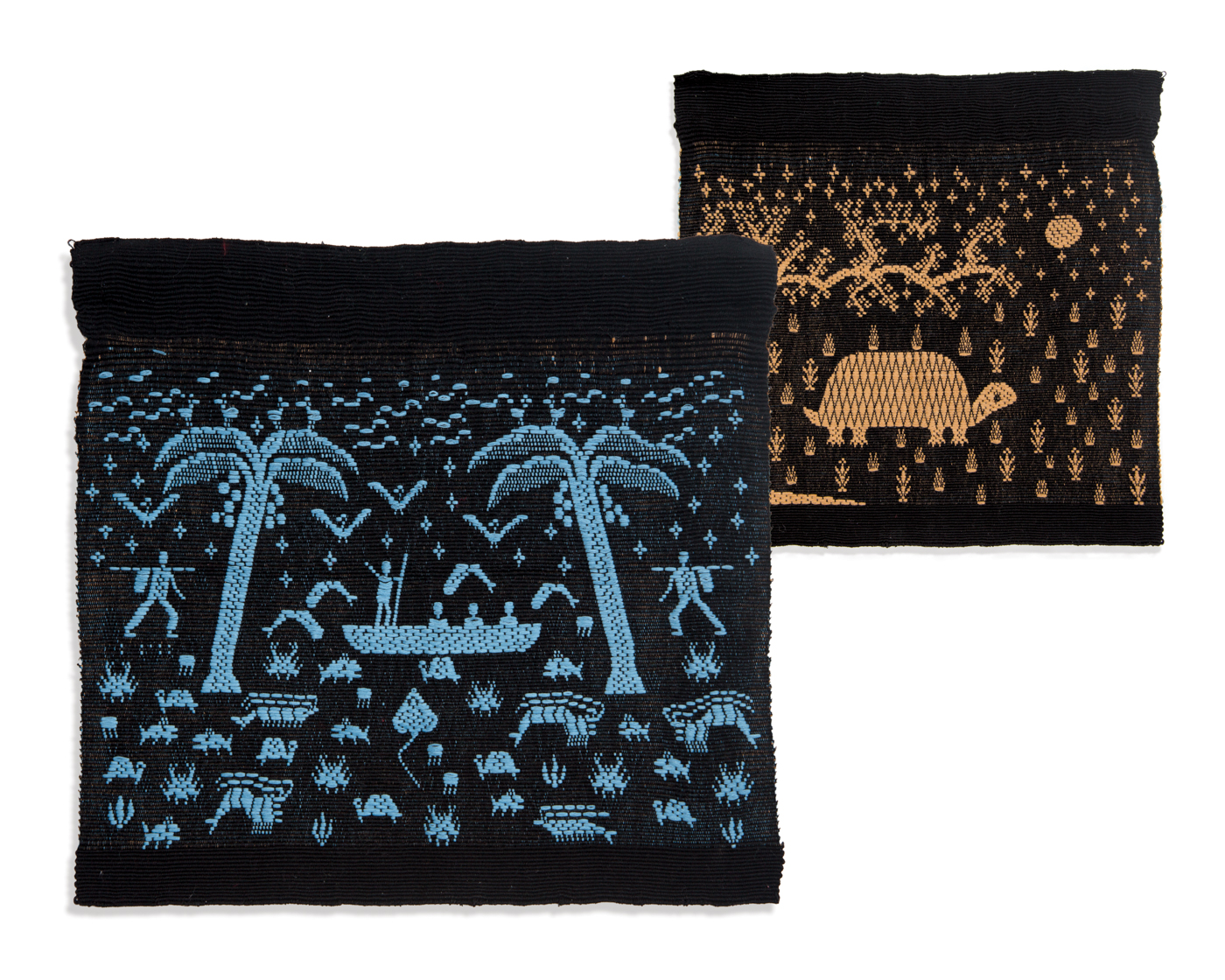Santo Tomás Jalieza
BACKSTRAP LOOM COTTON WEAVING
In Santo Tomás Jalieza, approximately 35 minutes from Oaxaca, spinning and weaving of cotton are carried out entirely by hand. The sign Textiles de algodón hecho a mano (cotton textiles made by hand) announces your arrival. Belts are created with the use of the back strap loom, a technique that dates back to 900 B.C. A left turn takes you into town. Neatly trimmed bougainvilleas, many in brilliant shades of magenta and rose, decorate the street. Almost immediately to the left is a small market in front of which there are always several women and girls demonstrating their techniques. This is where most tourists purchase the woven crafts of Santo Tomás Jalieza. Friday is the day when about 30 women are selling their work, as compared with perhaps ten on the other days of the week. The formation of an artesans’ union in Santo Tomás has resulted in the unusual practice of standardizing prices for items of comparable size, materials, and quality.
Erick Aguilar Mendoza
[Honorable mention in textiles, FOFA’s 2016 contest]
Pueblo of Santo Tomas Jalieza
González Ortega #7
erick.nic.0547@gmail.com
(From US) Cell: 011-52-951-180-2156
(In Oaxaca) Cell: 951-180-2156
Erick both challenges and perpetuates tradition. Backstrap loom cotton weaving has typically been the work of women, so Erick’s interest and growing mastery of this traditional weaving technique represents a new expression. And while most of the young people in his pueblo have no interest in the traditional crafts, Erick is inspired by his cultural heritage. Erick honors his roots by using natural dyes. FOFA’s 2016 contest was his first competitive event. His belt consists of thirty-two figures, including turkeys, deer, a woman carrying a basket, a monkey, serpents, and dancers. These designs are among the fifty shared by weavers in his pueblo, and are not specific to his family.
Fernando Daniel Hernández Salones
[Honorable mention in “Other textiles,” FOFA’s 2018 contest]
Pueblo of Santo Tomás Jalieza
Tercera Privada del Pósito
wendhysalones@gmail.com
(From US) Cell: 011-52-951-222-7427
(In Oaxaca) Cell: 951-222-7427
Fernando, who began learning his art form at five years of age, comes from a long line of back strap loom weavers on his father’s side. His finely detailed choker style necklace celebrates the women of his pueblo. With 18 distinct designs, he conveys his view of their invaluable roles: nourishing their families and animals (woman with basket), cultivating the fields (woman with hat), and being the “economic motor” (weaving) of the pueblo. Women also enlighten and guide (star) and bestow love (heart) upon their families and fellow pueblo members. The necklace’s blue and yellow tones are achieved with natural dyes made of indigo (which he likens to love as immense as the blue sky) and marigolds (that perpetually 48 bloom each year).
The Navarro Gómez Family
Pueblo of Santo Tomás Jalieza
Calle Benito Juárez #42
(From US) Landline: 011-52-951-528-1114
(In Oaxaca) Landline: 528-1114
In their spacious and tranquil yard, replete with bursts of brilliant purple and pink bougainvilleas, Mariana Gómez Jiménez and her three daughters, Margarita, Crispina and Inés, sit side by side on the ground, each working at her own backstrap loom tethered to a tree. Adjacent is an expansive patio where the family’s wide array of woven goods is displayed. The women of the Navarro Gómez family produce an unusually large number of woven cotton items: traditional belts, bags, place mats, coasters, table runners and napkins, wallets, change purses, belts with leather trim, eye glass and cell phone cases, and pillows created with woven segments mounted in leather. Crispina’s specialty is remarkably fine woven bags and belts, for which she has won many awards.
Balbina Mendoza Navarro (Maria’s granddaughter)
[Honorable mention in textiles, FOFA’s 2016, 2018 contests]
Calle Benito Juárez #42
From US: Landline: 011-52-951-528-1114
Cell: 011-52-951-305-8096
In Oaxaca: Landline: 528 -1114
Cell: 951-305-8096
Balbina both honors the old designs of her pueblo and looks toward the future by incorporating new designs. Having grown up in a talented family dedicated to the highest quality backstrap loom cotton weaving, she began to work at six years of age and is now teaching her three-year-old daughter. Balbina finishes her belts at each end with carefully formed figures of children who embody happiness, dreams and stories.
WOVEN CLOTHING
Mitla
Mauricio Gael Cuevas Magaña
[Honorable mention in “Other textiles,” FOFA’s 2018 contest]
Pueblo of Santa María El Tule
Colectivo Arte Textil Orozco, Calle Privada de la Raya #4
mcuevas2207@gmail.com
(From US) Cell: 011-52-552-295-5206
(In Oaxaca) Cell: 552-295-5206
Six years ago Mauricio learned to weave on a back strap loom in an artisans’ cooperative in Mexico City where he grew up. From there he developed an interest in learning more about the weaving techniques of his great-grandparents, who were from Oaxaca, as well as an interest in alternative fibers which led him to visit Oaxaca for workshops, and ultimately to move there which he did approximately one year before entering the 2018 contest. Now a member of a weaving cooperative in Oaxaca, Mauricio enjoys combining ancient techniques with the variety of natural materials available in Oaxaca. For his scarf, woven over a four-month period, Mauricio used bamboo fibers for the warp, and goose feathers and baby alpaca for the weft. Mauricio espouses the benefits of mutual collaboration, which the workshop provides; for example, a fellow member assisted him with the fringes.
Mauricio Méndez Martínez
[Honorable mention in textiles, FOFA’s 2016, 2018 contests]
Pueblo of Mitla del Valle
Morelos #28
virusdac_ska@hotmail.com
(From US) Landline: 011-52-951-568-0061
Cell: 011-52-951-557-1537
(In Oaxaca)
Landline: 568-0061
Cell: 951-557-1537
Growing up in Mitla, Mauricio was always fascinated and inspired by the archaeological ruins that his village embraces. In this weaving he casts light on the culture of his ancient ancestors reflected in the columns, geometric motifs, and distinct regions within the archaeological zone. This piece combines silk with the unusual addition of linen which was given to his grandfather by a Swede, and was woven on one of his family’s looms. Mauricio’s family works together in a single workshop. Mauricio explains that the rhythm of their looms conveys family harmony that prevents the threads from breaking, providing him with the serenity he needs to create his weavings.
Teotitlán del Valle
The Sosa Family
Rebeca Rubí Martínez Sosa
[Winner in textiles, FOFA’s 2016 contest; Honorable mention in Textiles, FOFA’s 2018 contest]
Pueblo of Teotitlán del Valle
Quinta Sección-Privada de Oriente #5
0215rubi@gmail.com
(From US) Landline: 011-52-951-524-4530
Cell: 011-52-951-289-9913
(In Oaxaca) Landline: 24-4530
Cell: 951-289-9913
This piece captures all that Rebeca Rubí has learned since she moved to the house of her in-laws in Oaxaca in 2014. She has become proficient with the four-pedal loom, which enables her to produce very soft cloth. This woven piece, special to her, comes from silk worms she and her husband jointly raised. He constructed a machine to card the silk, and her father-in-law taught her how to tie the macramé fringe. The family uses only natural dyes, in this case indigo. The rhomboid design represents water. She addressed the FOFA competition’s theme – honoring roots and exploring dreams -- by incorporating buttons from belts men wore long ago in this modern-day scarf.
Fabiola Contreras Sosa
[Winner in Textiles, FOFA’s 2013 contest; Honorable mention in Textiles, FOFA’s 2018 contest]
Pueblo of Teotitlán del Valle
Privada de Oriente #5
(From US) Landline: 011-52-951-524-4530
(In Oaxaca) Landline: 524-4530
Fabiola made this blouse for herself to wear in the celebratory processions in her village. She learned the technique randa de aguja (lattice work created by tying threads around one another) in a course in the neighboring pueblo of Tlacolula. Her piece has many meanings, incorporating pre-Hispanic elements; small figures on the smocked bodice which represent water and serpents; stars in the sky; and glyphs that signify day and night, or perhaps the balance between good and bad on earth. To make the male and female figures, she employed a technique locally known as hazme si puedes (make me if you can), a challenging reference to the difficult technique.
Josefina Lazo Gutiérrez
[Honorable mention in “Other textiles,” FOFA’s 2018 contest]
Pueblo of Teotitlán del Valle
Pensamientos #7 Sección Quinta
(From US) Cell: 011-52-1-951-149-4265
(In Oaxaca) Cell: 951-149-4265
This poncho (quechquémitl) uses a traditional design sized for a young girl. Josefina wove it to show her daughters that they must live rooted in their community and valuing their culture. She believes that the strength of her pueblo, Teotitlán, is its weavings, but the interdependence of the people of the central valley for wool, natural dyes and fabrics also contributes to its strength. The dyes are natural, prepared with plants that her family sows and harvests. Josefina and her husband chose to live close to nature, using only sustainable dyes, in order to give their daughters a healthier life. According to her, “Children are the strength of our future.”
Oaxaca City
Jasmin Azucena Pinzón Palafox
[Honorable mention in textiles, FOFA’s 2013, 2016 contests]
Oaxaca City
Privada 4-A de Totontepec #109
Col. Siete Regiones
(From US) Cell: 011-52-951-364-2626
(In Oaxaca) Cell: 044-951-364-2626
Jasmín learned the art of weaving with a backstrap loom from her mother when she was eight years old in the fishing village of San Mateo del Mar, home of the Huave people. This huipil is made with three panels of very fine cotton thread woven with great care. Her designs, such as palm trees, birds, and fishermen, learned from her maternal ancestors, represent their roots in their village by the sea. The huipil is finished using an ancient technique - weaving backwards from the end without cutting the thread - that results in very clean lines and an elegant finish.Jasmín learned the art of weaving with a backstrap loom from her mother when she was eight years old in the fishing village of San Mateo del Mar, home of the Huave people. This huipil is made with three panels of very fine cotton thread woven with great care. Her designs, such as palm trees, birds, and fishermen, learned from her maternal ancestors, represent their roots in their village by the sea. The huipil is finished using an ancient technique - weaving backwards from the end without cutting the thread - that results in very clean lines and an elegant finish.
Susana Santiago Martínez
[3rd prize in “Other textiles,” FOFA’s 2018 contest]
Municipio San Antonio de la Cal
Avenida Luis Echeverría #136 A, Colonia Experimental
sams930811@hotmail.com
(From US) Cell: 011-52-951-264-3534
(In Oaxaca) Cell: 951-264-3534
In Susana’s pueblo, Santa María Zacatepec, the Taquate women continue to wear huipils and men also wear traditional clothes, which contributes to their sense of identity. This union of traditional garb and community identity is central to the strength of her people. Susana hopes to demonstrate the culture of her village with her blouse. She chose to embroider animals from men’s clothing that represent protective animal spirits, nahuales. However, she presented Tacuate iconography in a slightly modernized fashion, rendering the traditional form of embroidery in a more geometric pattern with the full color range of traditional clothing. Susana began embroidering at the age of 12.
San Bartolo Yahutepec
Eloísa Jiménez Felipe
[1st prize in “Other textiles,” FOFA’s 2018 contest]
Pueblo of San Bartolo Yahutepec
Revolución s/n, Barrio Santa Caterina
richi_danna@hotmail.com
(From US) Landline: 011-52-558-526-2099
Cell: 011-52-951-5505701
(In Oaxaca) Landline: 558-526-2099
Cell: 951-550-5701
Eloísa’s intricately woven shirt celebrates the longstanding traditions of her village, family and culture, while also showcasing her formidable technical skills. A fifth generation weaver, Eloísa, who started using a back strap loom when she was 11, enjoys “weaving every day.” The body of the shirt, its cuffs and collar feature rows of birds, animals, and images related to farming, nature, and her Zapotec heritage. These elements are intrinsic to her daily life and the history of her pueblo. Eloísa has a treasured photo of her great-great-grandmother wearing an exquisite shirt woven with silk yarn, with which Eloísa would also like to weave someday.
EMBROIDERED CLOTHING
Many types of embroidery can be found in Oaxaca, on both garments and domestic items, complementing patterns and colors that are woven into the fabric from which they are made. San Antonino Castillo Velasco, and its neighbor San Juan Chilateca, are the main pueblos within easy travel distance from Oaxaca City where this type of embroidery is created. The garments for which these pueblos are best known are called “wedding dresses.” Generally made from white cotton, they are flowing unwaisted dresses or blouses with elaborately embroidered decoration on the yoke, sleeves and front segments. In addition to embroidery, these garments may have crocheted portions around the arm section and neckline. Some may have a horizontal row of human figures embroidered in the smocked segment of the garment, a difficult technique known as hazme si puedes (literally translated as “make me if you can”). Artists range in quality from outstanding – those who produce only a few elaborately embroidered dresses or blouses per year – to more commercial artisans whose decoration is far simpler, who omit some of the elements considered crucial by the finer embroiderers. One clear indication of quality is the degree of delicacy and clarity of the hazme si puedes. Prices vary widely according to the excellence of the work.
Sandra Patricia Lucas Amador
[Honorable mention in “Other textiles,” FOFA’s 2018 contest]
Pueblo of San Antonino Castillo Velasco
Avenida Castillo Velasco #12
sandralucasamador@gmail.com
(From US) Cell: 011-52-951-366-1726
(In Oaxaca) Cell: 951-366-1726
Sandra has known how to sew, embroider and weave as long as she can remember. Now that she has entered the university to study marketing, she has made a very special wedding dress, incorporating original San Antonino embroidery around the bottom. She features the pansy, the flower of her village, explaining that each of 132 pansies is created with a different color, just as the people in her life are all different. The smocking with the rose of Castilla represents the unity of her people. For Sandra, strength is found in the unity of both the couple in marriage and the people of her pueblo.
Marco Antonio Peralta Velasco
[Honorable mention in textiles, FOFA’s 2016 contest]
Pueblo of San Juan Chilateca
Independencia #7
m.arq.o@outlook.es
(From US) Landline: 011-52-951-528-1274
Cell: 011-52-951-189-1370
(In Oaxaca) Landline: 528-1274
Cell: 951-189-1370
Marco Antonio learned embroidery from his mother and his aunts. “My teachers taught me the technique of embroidery, and I learned to bring feelings to it.” He explains that more men are doing embroidery than is commonly appreciated; however, because of gender norms, they put down their work and leave the room when visitors come. Marco seeks to “recover the craft for men,” so for FOFA’s 2016 competition he chose a man’s guayabera shirt on which to display the style of embroidery of his town. His title is a play on words in Spanish, which can be understood both as “blue pansies” and “blue thoughts and feelings.”
Faustina Sumano García
Pueblo of San Juan Chilateca
Cuauhtemoc #11
(From US) Landline: 011-52-951-528-1081
(In Oaxaca) Landline: 528-1081
Faustina is a master of gloriously detailed and colorful embroidery in the traditional “wedding dress” style. Her work has been featured in many books on masters of Mexican folk art and recognized in multiple contests. Her array of pieces is breathtaking, both in its range of design elements and color combinations. One dress is made of black silk with a mandarin collar, on which she embroiders stunning, multi-colored pansies and other flowers. Another consists of white embroidery on white cotton, while yet another features primarily pale blue embroidery on white cloth. She created her first wedding dress when she was 27 years old. Faustina prides herself in completing all parts of the process herself. She cuts the fabric, designs the figures, embroiders, sews the dress together, and then undertakes the embroidery. Finally she creates the crocheted portions and the hazme si puedes (the horizontal row of human figures just under the yolk).
The Cornelio Sánchez Family
Carmen Cornelio Sánchez
Avenida Castillo Velasco s/n
Pueblo of San Antonino Castillo Velasco
Libertad #1
Avenida Castillo Velasco s/n
(separate workshop of Carmen)
(From US) Landline: 011-52-951-571-0092
Cell: 011-52-951-123-5616 (Carmen)
(In Oaxaca) Landline: 571-0092
Cell: 951-123-5616
Five sisters -- Reina, Silvia, Antonina, Carmen and María de la Luz (from eldest to youngest) – carry out the traditions of their mother, Virginia Sánchez de Cornelio, to create fine hand-embroidered blouses and dresses for which their pueblo, San Antonino Castillo Velasco, has long been known. In addition to the traditional “wedding dresses” and blouses, the members of the Sánchez family have introduced more contemporary items, such as embroidered skirts and everyday dresses for adults and children. The Sánchez’s are one of the few remaining families who carry out their pueblo’s embroidery tradition. Their greatest hope is that their tradition will not be lost, that the younger generation will perpetuate their art.
Miriam Leticia Campos Cornelio
Honorable mention in textiles, FOFA’s 2013 contest] (daughter of Reina)
Pueblo of San Antonino Castillo Velasco
Avenida Castillo Velasco s/n
miriamlcc@hotmail.com
(From US) Landline: 011-52-951-539-6097
Cell: 011-52-951-136-4888
(In Oaxaca) Landline: 539-6097
Cell: 951-136-4888
Miriam, a chemical engineer, continues the work of her female line of embroiderers. She believes in combining efficiency, good design, and tradition. Her small purse, in the style of her village, features colorful flowers and birds. The fabric, tightly gathered at the top and embroidered with Mother on one side and Earth on the other, replicates a technique used by her grandmother. Miriam’s professional life does not leave her much time for the embroidery she loves. She wishes she had time to produce a larger piece. “After all,” she says, “a woman carries everything in her purse.”
Carolina Sandoval Melchor
[Honorable mention in textiles, FOFA’s 2016 contest]
Pueblo of San Martín Tilcajete
Calle Tilcajete #6
carolinasanmel@gmail.com
(From US) Mother’s Cell: 011-52-951-228-2485
[Carolina is currently studying in Mexico City]
(In Oaxaca) Mother’s Cell: 951-228-2485
Since the age of five Carolina has devoted herself to the visual arts, and now has shifted her focus to embroidery. Carolina learned to embroider from her mother who learned from both her mother and father. This dress reflects the cultural and regional diversity of Oaxaca, including religion, dress, gastronomy, plant and animal life, and produce. First Carolina painted the figures of each region on transparent paper. Next she placed the drawings on top of the fabric, positioning them with geographic accuracy as if creating a map. Finally she filled in the details representing the various cultures of the state.
WOVEN DECORATIVE HOUSEHOLD ITEMS
Woven cotton cloth is used for home decoration (finished tablecloths and bedspreads, and unfinished yard goods suitable for curtains and pillows) and clothing, including shawls (rebozos). Cloth for home decoration is produced primarily in the Xochimilco section of Oaxaca City, as well as in the pueblo of Mitla, while cloth for clothing is primarily produced in Mitla. In the residential Xochimilco section of the city of Oaxaca – about a 15 minute walk from the central zocalo -the click-clack of shuttle looms can be heard in a number of home workshops.
Mitla, located approximately 45 kilometers (50 minutes or more) from Oaxaca, is home to the famous Zapotec ruins that inspire many patterns. The artisans of this pueblo create a wide range of cotton weaving for blouses, dresses, rebozos, shirts, pants, bedspreads and tablecloths. Many decorative elements exist, including geometric patterns based on the local pre-Hispanic ruins, lattice-work within the weaving itself, and embroidery and crocheting added to the weaving. A daily market with all types of goods, but especially clothing and other woven items, stands adjacent to the ruins that are enclosed by a wall of cactus. The winding road leading into the pueblo’s center (called the 5 de Febrero) is similarly lined with countless shops presenting rich displays of woven products.
Yaolt Hernández Ramírez
|[Honorable mention in “Other textiles,” FOFA’s 2018 contest]
Pueblo of Santa María El Tule
Colectivo Arte Textil Orozco, Calle Privada de la Raya #4
yaolthdz@gmail.com
(From US) Cell: 011-52-554-250-7156
(In Oaxaca) Cell: 554-250-7156
In generations past, the Xochimilcho neighborhood in Oaxaca City was home to a thriving pedal loom cotton weaving community, some descendants of whom continue to work today. Yaolt belongs to a rural cooperative outside of the city founded by the son of Xochimilcho weavers. In his richly textured throw blanket, he was inspired to use the lanzadera corrida (running shuttle) technique they prefer. Yaolt learned basic techniques from his father at age 10, and began working on a pedal loom five years ago. “I still have much to learn,” he says. Remarkably, he completed his blanket in just four days, selecting a design that is woven as a circle and yet appears as a diamond-shaped pattern when finished.
The Orozco Family
Xochimilco section of Oaxaca City
(10-15 minute walk from the center of town)
Santo Tomas #214
textiles_orozco@yahoo.com.mx
(From US) Cell: 011-52-951-130-6907
(In Oaxaca) Cell: 951-130-6907
Guadalupe Orozco Torres and her husband, Alejandro Rojas Miguel, buy crude cotton and wash it to remove impurities. It is then carded, spun into thread and placed on spools, to be used on large weaving looms; the cotton thread is subsequently dyed with chemical dyes. Although Guadalupe and all of her siblings grew up learning to card and spin cotton thread from an early age, she is the only one to perpetuate the family’s tradition, producing durable cotton fabric from which table cloths and bedspreads of all sizes, table napkins, tortilla napkins, curtains, towels, and place mats can be created.
Esperanza Martínez Velasco
[Honorable mention in “Other Modalities,” FOFA’s 2016, 2018 contests]
Pueblo of San Pedro Cajonos
Calle Sin Nombre s/n
esmave2010@hotmail.com
(From US) Landline: 011-52-951-351-2215
Cell: 011-52-951-222-0221
(In Oaxaca) Landline: 351-2215
Cell: 951-222-0221
Esperanza is from a family that cultivates silk and weaves textiles. As the youngest child, she began to experiment in order to distinguish herself. She took design courses and learned about the work of other artisans. She was 13 years old when she began using silkworm cocoons to make flowers and jewelry. This table runner is a new design, made of cut cocoons dyed with cochineal and then sewn together with silk thread. It is inspired by the colors of nature and the shapes of leaves and flower petals. The runner represents the work of her family, united and strong.
Liliana Paola Pinzón Palafox
[Honorable mention in “Other textiles,” FOFA’s 2018 contest]
Oaxaca City
Playa del Amor #228, Ampliación 7 Regiones
ppinzon856@gmail.com
(From US) Cell: 011-52-951-193-8547
(In Oaxaca) Cell: 951-193-8547
In Liliana Paola’s remarkable weaving, distinct figures and color palettes appear on each side without a trace of these showing on the reverse side. On the blue side she illustrated the calm sea of fisherman, a job requiring great strength, while the beige side portrays the dry season when land turtles appear because the lagoons dry up. According to Liliana Paola, who resides in Oaxaca City, no one in her native coastal San Mateo del Mar weaves this way anymore, with the exception of her mother who passed this technique to her. She wants people to be aware of artistic skills that are disappearing and the complexity of this technique.
